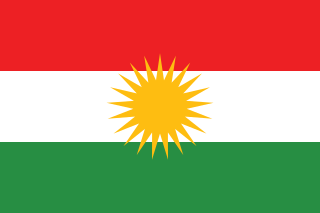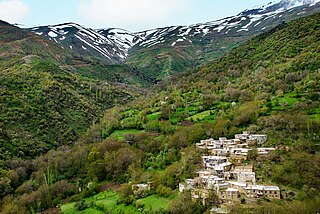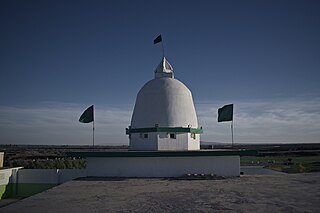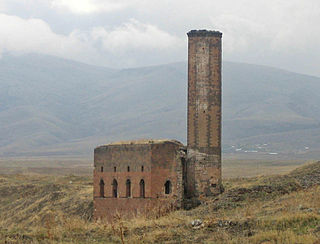
The festival of Pir Shalyar (also spelled as Shaliyar) is an old traditional ceremony in Kurdistan. It is held in the 40th day of winter. The celebration is held in three stages, each in a day of three consecutive weeks.

The festival of Pir Shalyar (also spelled as Shaliyar) is an old traditional ceremony in Kurdistan. It is held in the 40th day of winter. The celebration is held in three stages, each in a day of three consecutive weeks.
Pir (saint/magi) Shalyar (vizier), i.e. Pir Shaliyar is believed to have cured a Bukharan princess and married her; the ceremony marks their marriage. [1] It's also believed to be the 'oldest' literary text in Kurdish before the Islamization of Kurdistan. [2]
The word "Pir Shalyar" consists of three parts, each of them has different meaning. "Pir" from the point of view of Mithraism is said to someone who has passed the seven stages of this creed. "Sha" is told whose have magnitude and greatness that could catch people's attention. "Liyar" is the third part of the word and means mate, deputy and agent. Actually, "Pir Shalyar" has been an historical myth that was living hundreds of years ago under the name of king of kings or master of masters.
Pir Shalyar from the laymen perspective:
From the laymen perspective, Pir Shalyar is the second name of Seyyed Mostafa who has changed the sacred book of the first Pir Shalyar under the name of "epistemology of Pir Shalyar" and has written about Islamic doctrine, moreover he changed her name to Mostafa, the son of God.
As written in historical books, the first Pir Shalyar is Siaw the son of Jamasb was living 150 years before BC. He has been a Zoroastrian follower and the writer of the book "Epistemology of Pir Shalyar".
The second Pir Shalyar is Seyyed Mostafa Khodadadi, who was living in the age of Sheikh Abdul Qadir Gilani in the year 561 AH and has been totally familiar with thoughts an idea of first Pir Shalyar. Seyyed Mostafa has changed the Zoroastrian creed in the book and added the Islamic teaching instead.
In the first week children inform the people of the coming of the ceremony with distribution of walnuts to every home. [3]
In the second week, at the Wednesday night before sunrise, children go up to the roofs of homes, singing the traditional Kurdish songs. Shortly after sunrise cows and sheep are sacrificed. In the evening they play Daf and pray repeating spiritual hymns. [3]
In the third Friday of the month Rebendan (second month of winter in Kurdish calendar), golden breads made of wheat and walnut in the shape of the sun (disc) are brought to the tomb of Pir to be distributed among participants and eaten. [3]

Kurdish people or Kurds are an Iranic ethnic group native to the mountainous region of Kurdistan in Western Asia, which spans southeastern Turkey, northwestern Iran, northern Iraq, and northern Syria. There are exclaves of Kurds in Central Anatolia, Khorasan, and the Caucasus, as well as significant Kurdish diaspora communities in the cities of western Turkey and Western Europe. The Kurdish population is estimated to be between 30 and 45 million.

Kurdish is a Northwestern Iranian language or group of languages spoken by Kurds in the region of Kurdistan, namely in Turkey, northern Iraq, northwest and northeast Iran, and Syria.

Nowruz is the Iranian or Persian New Year celebrated by various ethnic groups worldwide. It is a festival based on the spring equinox—which marks the first day of the new year in the Iranian Solar Hijri calendar, on or around 21 March on the Gregorian calendar.

Kurdistan or Kordestan province is one of the 31 provinces of Iran. The province is 28,817 km2 in area and its capital is the city of Sanandaj. Other counties with their major cities are Saqqez, Baneh, Marivan, Qorveh, Bijar, Kamyaran, Dehgolan, Diwandarreh and Sarvabad.

Yarsanism, Ahl-e Haqq, or Kaka'i, is an inherited, syncretic religion founded by Sultan Sahak in the late 14th century in western Iran. The total number of followers of Yarsanism is estimated to be over half a million to one million in Iran. The numbers in Iraq are unknown. Followers are mostly Kurds from the Guran, Sanjâbi, Kalhor, Zangana and Jalalvand tribes. Turkic-speaking Yarsan enclaves also exist in Iran.

The flag of Kurdistan is the flag of Kurds and was created by the Society for the Rise of Kurdistan in 1920. It would later, in different variants, be adopted as the national flag of different Kurdish states including Republic of Ararat, Republic of Mahabad and most recently by Kurdistan Region in 1992. Moreover, the Kingdom of Kurdistan used the crescent flag which was also considered a Kurdish flag.

Yazidism, also known as Sharfadin, is a monotheistic ethnic religion that originated in Kurdistan and has roots in a western Iranic pre-Zoroastrian religion directly derived from the Indo-Iranian tradition. It is followed by the mainly Kurdish-speaking Yazidis and is based on belief in one God who created the world and entrusted it into the care of seven Holy Beings, known as Angels. Preeminent among these Angels is Tawûsî Melek, who is the leader of the Angels and who has authority over the world.

Avroman or Hawraman, is a mountainous region located within the provinces of Kurdistan and Kermanshah in western Iran and in north-eastern Kurdistan Region in Iraq. The main part of the Hawraman region is located in Iran and encompasses two components of the Central-Eastern Valley ; and the Western Valley. The mode of human habitation in these two valleys has been adapted over millennia to the rough mountainous environment. Tiered steep-slope planning and architecture, gardening on dry-stone terraces, livestock breeding, and seasonal vertical migration are among the distinctive features of the local culture and life of the Hawrami Kurdish people who dwell in lowlands and highlands during different seasons of each year. On July 27, 2021, part of the Hawraman region along with Uramanat were inscribed on the UNESCO World Heritage List as a cultural site under the name "Cultural Landscape of Hawraman/Uramanat".

Kurdistan Region is an autonomous administrative entity within the Republic of Iraq. It comprises four Kurdish-majority divisions of Arab-majority Iraq: the Erbil Governorate, the Sulaymaniyah Governorate, the Duhok Governorate, and Halabja Governorate. The KRI is bordered by Iran to the east, by Turkey to the north, and by Syria to the west. It does not govern all of Iraqi Kurdistan, and lays claim to the disputed territories of northern Iraq; these territories have a predominantly non-Arab population and were subject to the Ba'athist Arabization campaigns throughout the late 20th century. Though the KRI's autonomy was realized in 1992, one year after Iraq's defeat in the Gulf War, these northern territories remain contested between the Kurdistan Regional Government and the Government of Iraq to the present day. In light of the dispute, the KRI's constitution declares the city of Kirkuk as the capital of Iraqi Kurdistan. However, the KRI does not control Kirkuk, and the Kurdistan Region Parliament is based in Erbil. In 2014, when the Syria-based Islamic State began their Northern Iraq offensive and invaded the country, the Iraqi Armed Forces retreated from most of the disputed territories. The KRI's Peshmerga then entered and took control of them for the duration of the War in Iraq (2013–2017). In October 2017, following the defeat of the Islamic State, the Iraqi Armed Forces attacked the Peshmerga and reasserted control over the disputed territories.
Minorities in Iraq include various ethnic and religious groups.
Religion in Iraq dates back to Ancient Mesopotamia, particularly Sumer, Akkad, Assyria and Babylonia between circa 3500 BC and 400 AD, after which they largely gave way to Syriac Christianity and later to Islam.

Kurds in the United States refers to people born in or residing in the United States of Kurdish origin or those considered to be ethnic Kurds.

Simko Shikak born 1887, was a Kurdish chieftain of the Shekak tribe. He was born into a prominent Kurdish feudal family based in Chihriq castle located near the Baranduz river in the Urmia region of northwestern Iran. By 1920, parts of Iranian Azerbaijan located west of Lake Urmia were under his control. He led Kurdish farmers into battle and defeated the Iranian army on several occasions. The Iranian government had him assassinated in 1930. Simko took part in the massacre of the Assyrians of Khoy and instigated the massacre of 1,000 Assyrians in Salmas.
Iranian literature, or Iranic literature, refers to the literary traditions of the Iranian languages, developed predominantly in Iran and other regions in the Middle East and the Caucasus, eastern Asia Minor, and parts of western Central Asia and northwestern South Asia. These include works attested from as early as the 6th century BC. Modern Iranian literatures include Persian literature, Ossetian literature, Kurdish literature, Pashto literature, and Balochi literature, among others.

The Kurdistan Region parliamentary elections of 2009 took place on 25 July 2009. A total of 2.5 million citizens of Kurdistan Region were eligible to vote for the parliamentary and presidential elections. People currently living outside Kurdistan Region were not allowed to vote. The elections followed the 2005 Kurdistan Region parliamentary election. The parliamentary elections coincided with the direct election of the President of Kurdistan. Unlike the parliamentary elections in 2005, the president of Kurdistan was to be chosen directly through popular votes. A referendum to approve the constitution of Kurdistan Region originally planned for the same day was put back to 1 August.
The Central District of Saqqez County is in Kurdistan province, Iran. Its capital is the city of Saqqez.

The main religions that exist or historically existed in Kurdistan are as follows: Sunni Islam, Shia Islam, Christianity, Zoroastrianism, Yarsanism, Yazidism, Alevism and Judaism. Overall today, Sunni Islam is the most adhered to religion in Kurdistan.
Literature in Iran encompasses a variety of literary traditions in the various languages used in Iran. Modern literatures of Iran include Persian literature, Azerbaijani literature, and Kurdish literature, among others.
In traditionalist philosophy, desacralization of knowledge or secularization of knowledge is the process of separation of knowledge from its perceived divine source—God or the Ultimate Reality. The process reflects a paradigm shift in modern conception of knowledge in that it has rejected divine revelations as well as the idea of spiritual and metaphysical foundations of knowledge, confining knowledge to empirical domain and reason alone. Although it is a recurrent theme among the writers of the Traditionalist school that began with René Guénon, a French mystic and intellectual who earlier spoke of "the limitation of knowledge to its lowest order", the process of desacralization of knowledge was most notably surveyed, chronicled and conceptualized by the Iranian philosopher Seyyed Hossein Nasr in his 1981 Gifford Lectures that were later published as Knowledge and the Sacred.

Spread of Islam among Kurds started in the 7th century with the Early Muslim conquests. Before Islam, the majority of Kurds followed a western Iranic pre-Zoroastrian faith which derived directly from Indo-Iranian tradition, some elements of this faith survived in Yezidism, Yarsanism and Kurdish Alevism. When Islam first appeared, the Kurds were divided between the Byzantine and Sassanian Empires. The term "Kurd" back then referred to any Iranian nomad from any Iranian ethnic group whether in central Asia or western Iran regardless of geographic location or Iranian ethnicity. Jaban al-Kurdi and his son Meymun al-Kurdi were the first Kurds who converted to Islam and Khalil al-Kurdi as-Semmani was one of the first Kurdish tabi'uns. Mass conversion of Kurds to Islam didn't happen until the reign of Umar ibn Al-Khattab, second caliph of the Rashidun Caliphate between 634-644. The Kurds first came into contact with the Arab armies during the Arab conquest of Mesopotamia in 637. The Kurdish tribes had been an important element in the Sasanian Empire, and initially gave it strong support as it tried to withstand the Muslim armies, between 639 - 644. Once it was clear that the Sassanians would eventually fall, the Kurdish tribal leaders one by one submitted to Islam and their tribe members followed in accepting Islam. Today the majority of Kurds are Sunni Muslims, and there are Alevi and Shia minorities. Sunni Muslim Kurds are mostly Shafiʽis and Hanafis.